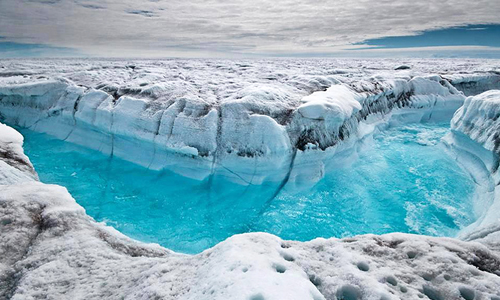
Burning All Fossil Fuels Would Lead to a 17 C Rise in Arctic Temperatures

Reality Check
So, how likely is it that we will get close to the 5tn tons figure? Is it purely hypothetical or a realistic worst-case scenario?
To give some perspective, the authors equate 5tn tons of carbon “approximately to the unregulated exploitation of the fossil fuel resource.”
In other words, it is about equivalent to how much fossil fuels is thought to exist deep in earth’s crust, should we be able to burn it all, they say.
It’s worth a quick technical note here on fossil fuel “resources” and “reserves.” The authors point to a 2013 report by the International Energy Agency, which explains the difference as follows:
“Resources are those volumes that have yet to be fully characterized or that present technical difficulties or are costly to extract … Reserves are those volumes that are expected to be produced economically using today’s technology.”
But Monday’s study uses the term “fossil fuel resource” to mean the sum total of both reserves plus resources, Tokarska told Carbon Brief.
Since this total includes fossil fuels that are not currently economically recoverable—and, arguably, may never be—it could be suggested this is a hypothetical rather than realistic extreme scenario. Indeed, Tokarska acknowledged:
“Using an estimate of proven reserves would result in a lower warming estimate.”
But the distinction between reserves and resources is probably less relevant when looking so far into the future, said Allen. He told Carbon Brief:
“Many of today’s fossil carbon reserves would have been deemed resources 50 years ago, before it occurred to anyone we would develop technologies to extract oil from the deep ocean, for example or frack methane from rock. If the resource is there and we don’t get a grip on climate policy, it will get used someday.”
Either way—taking reserves or resources—the temperatures are huge.
It’s also worth noting that 5tn tons is at the low end of estimates of the total resource, Tokarska said. For example, the latest report from the Intergovernmental Panel on Climate Change (IPCC) puts the figure for fossil fuel resources in 2011 in the region of 8-13tn tons of carbon (31-50tn tons of CO2).
Thought Experiment
This is not the first time scientists have done this kind of “thought experiment.”
Meinshausen’s 2011 paper described what would happen if you take the IPCC’s high emissions scenario (RCP8.5) and continue it to 2300. The paper also contained a figure of ~5tn tons for the total cumulative carbon emissions under this zero-mitigation scenario.
Monday’s study essentially repeats the exercise with more complex models. Doing so highlights the importance for projections of carbon cycle feedbacks—knock on effects that can speed up or slow down the pace of warming. Prof. Richard Allan from the University of Reading told Carbon Brief, for example:
“The simulations show that the ability of the land to take up some of the carbon emissions and the deep ocean to take up the heat trapped by rising greenhouse gases begins to wane by the end of this century, which exacerbates warming.”
But while the authors of Monday’s study consider 5tn tons of carbon to be a reasonable estimate of where we could end up without any mitigation, the reality is likely to be different. As Allan put it:
“This is a useful ‘what if’ study that exercises computer simulations to their limits. But, in reality, the damage to societies and ecosystems by such severe climate change would cripple economies to such an extent that it would be practically impossible to burn all the fossil fuel reserves.”
YOU MIGHT ALSO LIKE
Bill Nye: Climate Deniers Are Wrong
Deadly Heat Wave Creates Havoc Across South Asia
Fossil Fuel Industry-Funded Attorneys General Try to Block Exxon Climate Fraud Probe
Scientists Confirm Fears About East Antarctica’s Biggest Glacier

 233k
233k  41k
41k  Subscribe
Subscribe 
